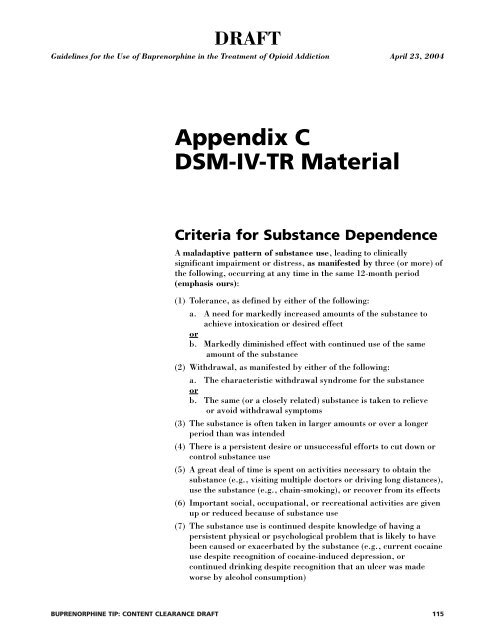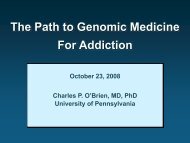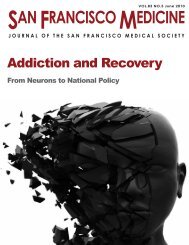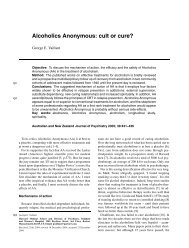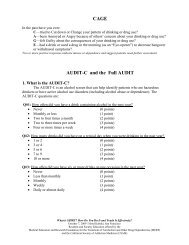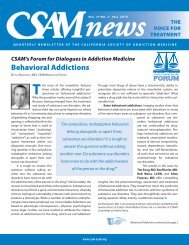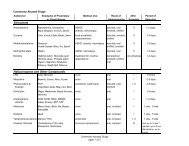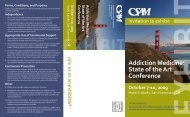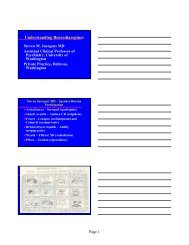Appendix C DSM-IV-TR Material Criteria for Substance Dependence
Appendix C DSM-IV-TR Material Criteria for Substance Dependence
Appendix C DSM-IV-TR Material Criteria for Substance Dependence
Create successful ePaper yourself
Turn your PDF publications into a flip-book with our unique Google optimized e-Paper software.
DRAFT<br />
Guidelines <strong>for</strong> the Use of Buprenorphine in the Treatment of Opioid Addiction April 23, 2004<br />
<strong>Appendix</strong> C<br />
<strong>DSM</strong>-<strong>IV</strong>-<strong>TR</strong> <strong>Material</strong><br />
<strong>Criteria</strong> <strong>for</strong> <strong>Substance</strong> <strong>Dependence</strong><br />
A maladaptive pattern of substance use, leading to clinically<br />
significant impairment or distress, as manifested by three (or more) of<br />
the following, occurring at any time in the same 12-month period<br />
(emphasis ours):<br />
(1) Tolerance, as defined by either of the following:<br />
a. A need <strong>for</strong> markedly increased amounts of the substance to<br />
achieve intoxication or desired effect<br />
or<br />
b. Markedly diminished effect with continued use of the same<br />
amount of the substance<br />
(2) Withdrawal, as manifested by either of the following:<br />
a. The characteristic withdrawal syndrome <strong>for</strong> the substance<br />
or<br />
b. The same (or a closely related) substance is taken to relieve<br />
or avoid withdrawal symptoms<br />
(3) The substance is often taken in larger amounts or over a longer<br />
period than was intended<br />
(4) There is a persistent desire or unsuccessful ef<strong>for</strong>ts to cut down or<br />
control substance use<br />
(5) A great deal of time is spent on activities necessary to obtain the<br />
substance (e.g., visiting multiple doctors or driving long distances),<br />
use the substance (e.g., chain-smoking), or recover from its effects<br />
(6) Important social, occupational, or recreational activities are given<br />
up or reduced because of substance use<br />
(7) The substance use is continued despite knowledge of having a<br />
persistent physical or psychological problem that is likely to have<br />
been caused or exacerbated by the substance (e.g., current cocaine<br />
use despite recognition of cocaine-induced depression, or<br />
continued drinking despite recognition that an ulcer was made<br />
worse by alcohol consumption)<br />
BUPRENORPHINE TIP: CONTENT CLEARANCE DRAFT<br />
115
DRAFT<br />
Guidelines <strong>for</strong> the Use of Buprenorphine in the Treatment of Opioid Addiction April 23, 2004<br />
Specify if:<br />
With Physiological <strong>Dependence</strong>: Evidence of<br />
tolerance or withdrawal (i.e., either Item 1 or<br />
2 is present)<br />
Without Physiological <strong>Dependence</strong>: No<br />
evidence of tolerance or withdrawal (i.e.,<br />
neither Item 1 nor 2 is present)<br />
<strong>Substance</strong> <strong>Dependence</strong><br />
Course Specifiers<br />
Six course specifiers are available <strong>for</strong><br />
<strong>Substance</strong> <strong>Dependence</strong>. The four Remission<br />
specifiers can be applied only after none of<br />
the criteria <strong>for</strong> <strong>Substance</strong> <strong>Dependence</strong> or<br />
<strong>Substance</strong> Abuse have been present <strong>for</strong> at<br />
least 1 month. The definition of these four<br />
types of Remission is based on the interval of<br />
time that has elapsed since the cessation of<br />
<strong>Dependence</strong> (Early versus Sustained<br />
Remission) and whether there is continued<br />
presence of one or more of the items included<br />
in the criteria sets <strong>for</strong> <strong>Dependence</strong> or Abuse<br />
(Partial versus Full Remission). Because the<br />
first 12 months following <strong>Dependence</strong> is a time<br />
of particularly high risk <strong>for</strong> relapse, this<br />
period is designated Early Remission. After 12<br />
months of early Remission have passed<br />
without relapse to <strong>Dependence</strong>, the person<br />
enters into Sustained Remission. For both<br />
Early Remission and Sustained Remission, a<br />
further designation of Full is given if no<br />
criteria <strong>for</strong> <strong>Dependence</strong> or Abuse have been<br />
met during the period of remission; a<br />
designation of Partial is given if at least one of<br />
the criteria <strong>for</strong> <strong>Dependence</strong> or Abuse has been<br />
met, intermittently or continuously, during<br />
the period of remission. The differentiation of<br />
Sustained Full Remission from recovered (no<br />
current <strong>Substance</strong> Abuse Disorder) requires<br />
consideration of the length of time since the<br />
last period of disturbance, the total duration<br />
of the disturbance, and the need <strong>for</strong> continued<br />
evaluation. If, after a period of remission or<br />
recovery, the individual again becomes<br />
dependent, the application of the Early<br />
Remission specifier requires that there again<br />
be at least 1 month in which no criteria <strong>for</strong><br />
<strong>Dependence</strong> or Abuse are met. Two additional<br />
specifiers have been provided: On Agonist<br />
Therapy and In a Controlled Environment.<br />
For an individual to qualify <strong>for</strong> Early<br />
Remission after cessation of agonist therapy<br />
or release from a controlled environment,<br />
there must be a 1-month period in which none<br />
of the criteria <strong>for</strong> <strong>Dependence</strong> of Abuse are<br />
met.<br />
The following Remission specifiers can be<br />
applied only after no criteria <strong>for</strong> <strong>Dependence</strong><br />
or Abuse have been met <strong>for</strong> at least 1 month.<br />
Note that these specifiers do no apply if the<br />
individual is on agonist therapy or in a<br />
controlled environment (see below).<br />
Early Full Remission: This specifier is used<br />
if, <strong>for</strong> at least 1 month, but <strong>for</strong> less than 12<br />
months, no criteria <strong>for</strong> <strong>Dependence</strong> or Abuse<br />
have been met.<br />
Early Partial Remission: This specifier is<br />
used if, <strong>for</strong> at least 1 month, but less than 12<br />
months, one or more criteria <strong>for</strong> <strong>Dependence</strong><br />
or Abuse have been met (but the full criteria<br />
<strong>for</strong> <strong>Dependence</strong> have not been met).<br />
Sustained Full Remission: This specifier is<br />
used if none of the criteria <strong>for</strong> <strong>Dependence</strong> or<br />
Abuse have been met at any time during a<br />
period of 12 months or longer.<br />
Sustained Partial Remission: This specifier is<br />
used if full criteria <strong>for</strong> <strong>Dependence</strong> have not<br />
been met <strong>for</strong> a period of 12 months or longer;<br />
however, one or more criteria <strong>for</strong> <strong>Dependence</strong><br />
or Abuse have been met.<br />
On Agonist Therapy: This specifier is used if<br />
the individual is on a prescribed agonist<br />
medication, and no criteria <strong>for</strong> <strong>Dependence</strong> or<br />
Abuse have been met <strong>for</strong> that class of<br />
medication <strong>for</strong> at least the past month (except<br />
tolerance to, or withdrawal from, the agonist).<br />
This category also applies to those being<br />
treated <strong>for</strong> <strong>Dependence</strong> using a partial agonist<br />
or an agonist/antagonist.<br />
In a Controlled Environment: This specifier<br />
is used if the individual is in an environment<br />
where access to alcohol and controlled<br />
116 <strong>DSM</strong>-<strong>IV</strong>-<strong>TR</strong> <strong>Material</strong><br />
BUPRENORPHINE TIP: CONTENT CLEARANCE DRAFT
DRAFT<br />
Guidelines <strong>for</strong> the Use of Buprenorphine in the Treatment of Opioid Addiction April 23, 2004<br />
substances is restricted, and no criteria <strong>for</strong><br />
<strong>Dependence</strong> or Abuse have been met <strong>for</strong> at<br />
least the past month. Examples of these<br />
environments are closely supervised and<br />
substance-free jails, therapeutic communities,<br />
or locked hospital units.<br />
<strong>Criteria</strong> <strong>for</strong> <strong>Substance</strong><br />
Abuse<br />
A maladaptive pattern of substance use<br />
leading to clinically significant impairment or<br />
distress, as manifested by one (or more) of the<br />
following, occurring within a 12-month<br />
period:<br />
• Recurrent substance use resulting in a<br />
failure to fulfil major role obligations at<br />
work, school, or home (e.g., repeated<br />
absences or poor work per<strong>for</strong>mance related<br />
to substance use; substance-related<br />
absences, suspensions, or expulsions from<br />
school; neglect of children or household<br />
• Recurrent substance use in situations in<br />
which it is physically hazardous (e.g.,<br />
driving an automobile or operating a<br />
machine when impaired by substance use)<br />
• Recurrent substance-related legal problems<br />
(e.g., arrests <strong>for</strong> substance-related<br />
disorderly conduct)<br />
• Continued substance use despite having<br />
persistent or recurrent social or<br />
interpersonal problems caused or<br />
exacerbated by the effects of the substance<br />
(e.g., arguments with spouse about<br />
consequence of intoxication, physical fights)<br />
The symptoms have never been met the<br />
criteria <strong>for</strong> <strong>Substance</strong> <strong>Dependence</strong> <strong>for</strong> this<br />
class of substance.<br />
Opioid <strong>Dependence</strong><br />
Refer, in addition, to the text and criteria <strong>for</strong><br />
<strong>Substance</strong> <strong>Dependence</strong>. Most individuals with<br />
Opioid <strong>Dependence</strong> have significant levels of<br />
tolerance and will experience withdrawal on<br />
abrupt discontinuation of opioid substances.<br />
Opioid <strong>Dependence</strong> includes signs and<br />
symptoms that reflect compulsive, prolonged<br />
self-administration of opioid substances that<br />
are used <strong>for</strong> no legitimate medical purpose or,<br />
if a general medical condition is present that<br />
requires opioid treatment, that are used in<br />
doses that are greatly in excess of the amount<br />
needed <strong>for</strong> pain relief. Persons with Opioid<br />
<strong>Dependence</strong> tend to develop such regular<br />
patterns of compulsive drug use that daily<br />
activities are typically planned around<br />
obtaining and administering opioids. Opioids<br />
are usually purchased on the illegal market<br />
but may also be obtained from physicians by<br />
faking or exaggerating general medical<br />
problems, or by receiving simultaneous<br />
prescriptions from several physicians. Health<br />
care professionals with Opioid <strong>Dependence</strong><br />
will often obtain opioids by writing<br />
prescriptions <strong>for</strong> themselves or by diverting<br />
opioids that have been prescribed <strong>for</strong> patients<br />
or from pharmacy supplies.<br />
<strong>DSM</strong>-<strong>IV</strong>-<strong>TR</strong> <strong>Material</strong><br />
BUPRENORPHINE TIP: CONTENT CLEARANCE DRAFT<br />
117
DRAFT<br />
Guidelines <strong>for</strong> the Use of Buprenorphine in the Treatment of Opioid Addiction April 23, 2004<br />
Other <strong>DSM</strong>-<strong>IV</strong> <strong>Substance</strong>-Related Disorders<br />
ICD-9-CM<br />
292.82 Persisting Dementia<br />
292.83 Persisting Amnestic Disorder<br />
292.11 Psychotic Disorder with Delusions<br />
292.12 Psychotic Disorder with Hallucinations<br />
292.84 Mood Disorder<br />
292.89 Anxiety Disorder<br />
292.89 Sleep Disorder<br />
292.89 Sexual Dysfunction<br />
292.89 Persisting Perception Disorder (Flashbacks)<br />
292.9 Disorder Not Otherwise Specified<br />
<strong>Substance</strong> Related Disorders<br />
305.01 Alcohol abuse, continuous<br />
305.02 Alcohol abuse, episodic<br />
305.03 Alcohol abuse, remission<br />
305.00 Alcohol abuse, unspec.<br />
303.00 Alcohol intoxication, acute, unspec.<br />
291.81 Alcohol withdrawal<br />
303.91 Alcoholism, chronic, continuous<br />
304.41 Amphetamine dependence, continuous<br />
304.11 Barbiturate dependence, continuous<br />
305.22 Cannabis abuse, episodic<br />
304.31 Cannabis dependence, continuous<br />
305.62 Cocaine abuse, episodic<br />
304.21 Cocaine dependence, continuous<br />
305.90 Drug abuse, unspec.<br />
305.92 Drug abuse, unspec., episodic<br />
304.90 Drug dependence, unspec.<br />
292.11 Drug-induced paranoia<br />
305.52 Opioid abuse, episodic<br />
304.01 Opioid dependence, continuous<br />
305.1 Tobacco abuse<br />
Source: Reprinted with permission from the Diagnostic and Statistical Manual of Mental<br />
Disorders, Fourth Edition, Text Revision. Copyright 2000. American Psychiatric Association.<br />
118 <strong>DSM</strong>-<strong>IV</strong>-<strong>TR</strong> <strong>Material</strong><br />
BUPRENORPHINE TIP: CONTENT CLEARANCE DRAFT


